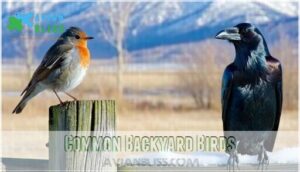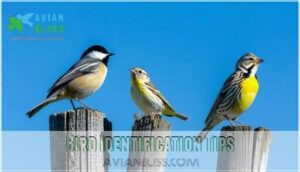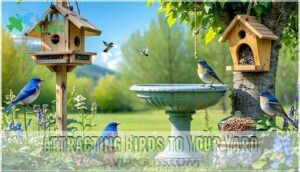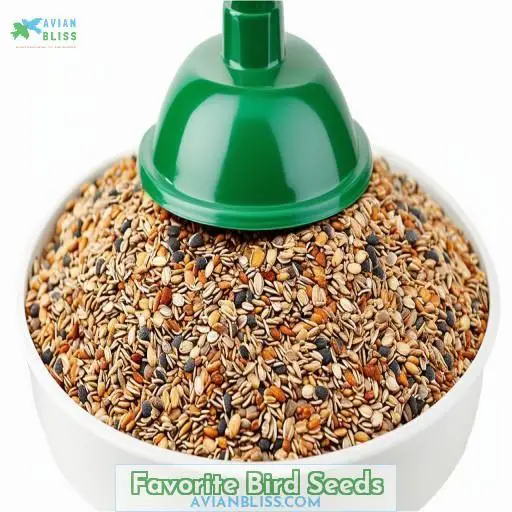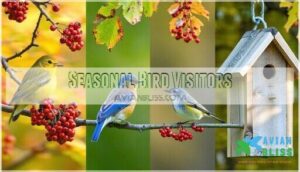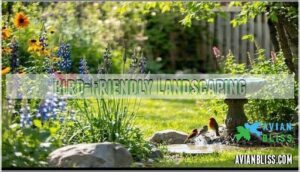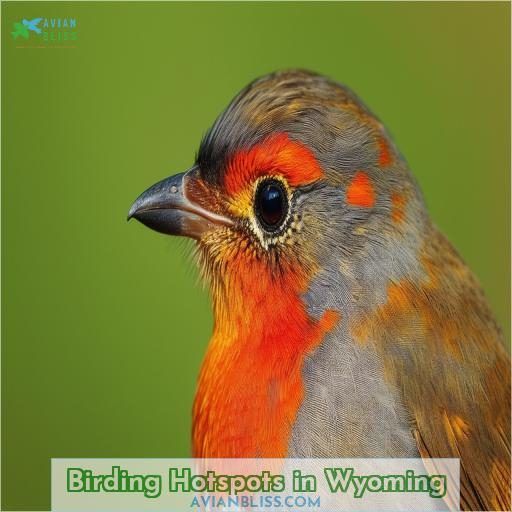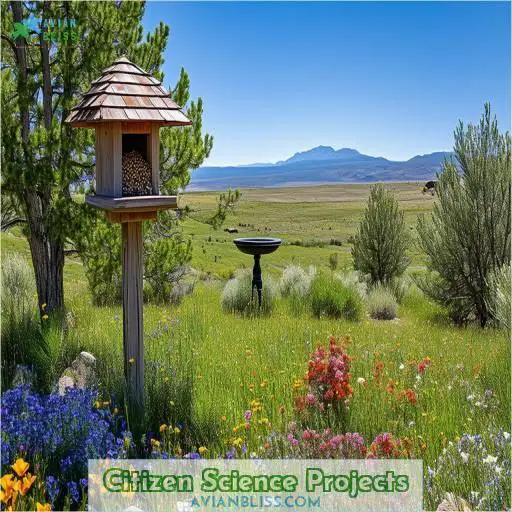This site is supported by our readers. We may earn a commission, at no cost to you, if you purchase through links.
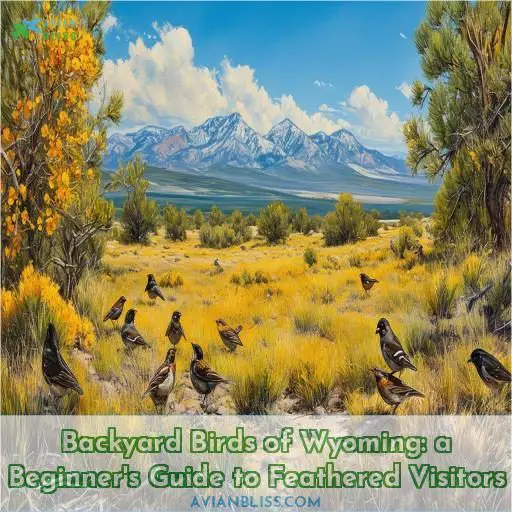
With the right bird-friendly landscaping, feeders, and water sources, you can attract an avian ensemble to your own slice of nature.
From learning bird identification tips to exploring hotspots in your state’s parks, immersing yourself in the avian realm of Wyoming’s backyard birds promises an enriching journey.
And this is just the beginning – a whole world of feathered wonders awaits those curious to embark on this captivating pursuit.
Table Of Contents
- Key Takeaways
- Common Backyard Birds
- Bird Identification Tips
- Attracting Birds to Your Yard
- Favorite Bird Seeds
- Backyard Bird Feeding Tips
- Seasonal Bird Visitors
- Bird-Friendly Landscaping
- Birding Hotspots in Wyoming
- Backyard Bird Photography
- Citizen Science Projects
- Frequently Asked Questions (FAQs)
- How do I identify a bird in my backyard?
- What is the best bird seed for Wyoming?
- Are there mockingbirds in Wyoming?
- What bird is black with white wings in Wyoming?
- What are the best nesting box designs?
- How can I prevent window collisions?
- What are common backyard bird diseases?
- How do I deter nuisance species?
- Conclusion
Key Takeaways
- Get ready to be serenaded by a raucous avian ensemble – from the iconic black-billed magpie’s spirited calls to the vibrant flashes of western tanagers dancing among the trees. Your Wyoming backyard is a veritable feathered paradise!
- Become a master of avian identification by studying size, shape, color patterns, behavior, and habitat clues. Oh, and don’t forget to tune your ears to their unique melodies – a bird’s song can be a dead giveaway!
- Roll out the welcome mat for feathered guests by providing a smorgasbord of tasty seeds, fresh water oases, and cozy nesting sites. Who knows, you might even attract a celebrity bird or two!
- Expand your birding horizons beyond the backyard by exploring Wyoming’s national parks, state parks, and wildlife refuges. These natural havens are teeming with avian diversity just waiting to be discovered (and photographed, if you’re feeling snap-happy!).
Common Backyard Birds
As a backyard birdwatcher, you’ll quickly become acquainted with common feathered visitors.
The American robin, with its reddish-orange breast, and the black-billed magpie, sporting a striking black-and-white plumage, are hard to miss.
Keep an eye out for the iridescent feathers of the common raven as it soars overhead.
The cheeky house sparrow and the familiar American crow will likely make frequent appearances too.
For a touch of vibrancy, the male house finch‘s vibrant red plumage and the northern flicker’s black-and-white patterning with a flash of red are a delight.
Bird Identification Tips
When identifying backyard birds in Wyoming, pay close attention to their size and shape, as these characteristics can provide valuable clues. From the stout, rounded profile of a chickadee to the sleek, streamlined silhouette of a swallow, observing a bird’s overall body form is an essential first step.
Color patterns, including wing bars, eye stripes, breast markings, and tail patterns, offer additional distinguishing features that can pinpoint the species.
However, behavior and habitat preferences also play an important role in proper identification, as certain birds exhibit unique foraging techniques, flight patterns, or preferences for specific environments.
Size and Shape
As you observe birds, notice their size relative to common objects – sparrows are around 6 inches, while hawks span 2-3 feet. Each species has a distinct silhouette: finches are compact, woodpeckers elongated. Study beak shapes too – thick for seed-eaters, slender for insectivores. Feather texture and wingspan provide further clues to identification.
Color Patterns
You can quickly identify many birds by their color patterns. Watch for:
- Blue and white: Mountain Bluebird, Black-throated Blue Warbler
- Red and black: Red-winged Blackbird, American Redstart
- Yellow and green: American Goldfinch, Yellow-rumped Warbler
- Brown and white: White-throated Sparrow, Spotted Towhee
- Green and yellow: Western Tanager, Yellow Warbler
Color combinations provide an easy first clue to a bird’s identity.
Behavior and Habitat
After noting color patterns, watch a bird’s behavior and preferred habitat for further ID clues. Listen for distinctive calls or songs. Observe nesting habits, like cavity nesters or open-cup builders. Note migratory patterns too – some species are year-round Wyoming residents, while others are seasonal visitors. Understanding behaviors and habitats enriches your backyard bird watching experience.
Attracting Birds to Your Yard
You can attract a variety of birds to your backyard by providing food, water sources, and nesting sites. Installing bird feeders stocked with quality seeds and suet, maintaining a clean water bath or dripper, and putting up nesting boxes or nesting material are effective ways to create a welcoming habitat for feathered visitors.
Feeders and Food
Present feeders stocked with appropriate food attract feathered visitors.
Offer seed dispensers with black oil sunflower, nyjer, and suet cakes to meet their nutritional needs.
Adjust offerings based on birds’ food preferences.
Finches favor nyjer.
Chickadees and nuthatches relish suet.
Place feeders near cover for safety from predators.
Consistently replenishing fresh seed rewards you with lively avian activity.
Water Sources
Providing fresh, clean water is essential for attracting birds. Install birdbaths or shallow water features with a depth of 1-3 inches. Place them near cover for safety, and make sure the water temperature stays cool. Birds like Canada Geese, Common Mergansers, Killdeers, and Rock Pigeons particularly appreciate accessible water sources.
Nesting Boxes
Providing nesting boxes is a great way to attract birds to your yard. Different species have preferences for nest box size, hole diameter, and height. Cedar and untreated wood are ideal materials. Position boxes facing a sheltered direction, away from predators. Clean out old nesting material annually. You can even construct roomy shelters for winter bird roosting.
Favorite Bird Seeds
To attract a wide variety of feathered friends to your backyard, you’ll want to offer three key seed types:
Black oil sunflower seeds, a favorite for many species including cardinals, grosbeaks, and jays.
Nyjer (or thistle) seeds for finches like goldfinches and pine siskins.
Nutrient-dense suet cakes, which provide essential fats for woodpeckers, nuthatches, and chickadees during the cold winter months.
Black Oil Sunflower Seeds
You can’t go wrong with black oil sunflower seeds as your main backyard bird food. They’re a favorite with many species like the:
- Eurasian collared-dove
- Mountain chickadee
- Dark-eyed junco
- Pine siskin and white-crowned sparrow
These nutty treats are rich in oils and proteins that birds crave. Purchase high-quality seeds without debris or shells for best results.
Nyjer (Thistle) Seeds
You’ll also want to offer nyjer (thistle) seeds to attract finches and pine siskins. These tiny black seeds are favorites of house finches, our state bird, and American goldfinches. Purchase nyjer feeders with small ports to dispense the seeds efficiently. Store nyjer in airtight containers – allowing them to get damp causes spoilage. Explore nyjer varieties for nutrient variety.
Suet Cakes
You’ll also want to offer suet cakes, a high-energy treat for insect-eating birds like woodpeckers, nuthatches, and blue birds. Suet is a nutrient-dense blend of animal fat, seeds, and sometimes fruit. You can purchase pre-made suet cakes or make your own by melting suet and mixing in ingredients like black oil sunflower seeds, peanuts, and raisins.
Backyard Bird Feeding Tips
Proper feeder placement and maintenance are essential for attracting and sustaining backyard birds. Position feeders in open areas, away from dense shrubs or overhanging branches, and regularly clean them to prevent the spread of diseases and maintain a fresh food supply.
Feeder Placement
After selecting the appropriate seeds, correct feeder placement is essential. Position feeders where you can readily observe feeding activity but provide some nearby concealment.
- Place feeders 4-6 feet from a window for optimal viewing
- Install at a height of 5-6 feet off the ground
- Locate feeders 10-20 feet from shrubs or trees for quick escapes
Feeder Maintenance
Regularly cleaning your feeders prevents the buildup of debris and disease. Rake below the feeders to remove droppings. Every two weeks, immerse the feeders in a bleach solution, scrub, and rinse thoroughly. Make sure seeds stay dry to deter mold and bacteria growth, harmful to birds. By maintaining proper hygiene, you create a safe, welcoming environment for feathered friends.
Squirrel-Proofing
You’ll want to squirrel-proof your feeders and bird-friendly spaces. Try hanging feeders on poles with baffles that spin or slope to prevent access. Squirrel-proof feeders with weight-sensitive perches can also help. For birdhouses and baths, smooth poles or wire cages protect from squirrels raiding nests or bathing areas. Store birdseed in airtight containers to deter rodents.
Seasonal Bird Visitors
You’ll have the opportunity to observe a diverse array of seasonal bird visitors in your Wyoming backyard. From vibrant spring migrants passing through on their way to breeding grounds to hardy winter residents braving the cold, each season brings its own unique feathered guests to enjoy and appreciate.
Spring Migrants
As winter fades, you’ll notice a flurry of avian activity, heralding the arrival of spring migrants. These winged wanderers return from warmer climes, enticed by breeding opportunities and abundant food. Observe territorial displays as they stake claims, and marvel at their intricate nesting behaviors and winter adaptations. With keen eyes and ears, you can appreciate their migrations’ rhythms.
Summer Breeders
As spring gives way to summer, you’ll witness a flurry of avian activity. Migratory songbirds return to breed and raise their young:
- Brilliant yellow warblers flit through foliage in search of insects
- Dazzling western tanagers perch atop trees, their red-headed beauty commanding attention
- Melodious house wrens tirelessly fetch food for hungry nestlings
- Raucous black-billed magpies noisily defend their territory
Savor this seasonal spectacle while it lasts – winter’s chill will soon drive these fair-weather residents south once more.
Winter Residents
As winter’s chill settles in, watch for hardy feathered friends frequenting your backyard feeders. Chickadees, nuthatches, and woodpeckers will jostle for prime perches, while nomadic flocks of redpolls, siskins, and grosbeaks may arrive in search of sustenance. With a bit of preparation, your winter birdwatching can thrive amidst the snow-covered habitats.
Bird-Friendly Landscaping
To create a bird-friendly backyard, incorporate native plants into your landscaping. Their flowers, fruits, and seeds provide natural food sources, while their foliage offers nesting materials and shelter for birds. Supplement plantings with brush piles made from pruned branches, which create safe havens for ground-feeding birds and small songbirds seeking protection from predators and the elements.
Native Plants
To truly make your yard a bird-friendly habitat, incorporate native plant species that support the local ecosystem. Native plants will attract insects for birds to eat, and they’ll also provide nesting materials and shelter, like creating a bird-friendly habitat. Here are some excellent choices:
- Serviceberry
- Chokecherry
- Sunflowers
- Coneflowers
- Milkweed
Native plants evolved alongside Wyoming’s birds, creating the perfect partnership. By landscaping with them, you’re sustaining backyard biodiversity.
Brush Piles
Constructing brush piles provides essential shelter for birds. Strategically place them near your feeders, using sticks, fallen branches, and logs. Maintain piles by adding new materials as needed. These shelters offer protection, nesting sites, and refuge for birds like wrens, sparrows, and towhees – benefiting backyard wildlife greatly.
Water Features
Water features like birdbaths and shallow water gardens are irresistible to birds. Offer a dripper or mister to add sound and movement, but clean regularly to prevent disease. Place near shrubbery for safety, and consider a heated birdbath for winter use. By providing essential hydration, you’ll attract a lively assortment of feathered friends year-round.
Birding Hotspots in Wyoming
Wyoming boasts an abundance of prime birding destinations, including the iconic Yellowstone and Grand Teton National Parks, renowned for their diverse avian inhabitants and awe-inspiring landscapes. State parks like Seedskadee and wildlife refuges such as the National Elk Refuge near Jackson offer excellent opportunities to observe a wide array of bird species in their natural habitats.
National Parks
You can’t beat the national parks for prime birding! Yellowstone’s abundant wildlife provides ample opportunities to spot raptors and waterfowl. Grand Teton’s stunning vistas pair perfectly with observing mountain bluebirds and western meadowlarks. At Seedskadee, join ranger-led walks to glimpse:
- Migrating shorebirds
- Nesting songbirds
- Elusive owl species
State Parks
If you’re keen to explore more birdwatching locations beyond national parks, Wyoming’s state parks offer prime opportunities. Spots like Curt Gowdy, Glendo, and Sinks Canyon boast well-marked birding trails and wildlife viewing areas teeming with avian diversity. Grab your binoculars and prepare for encounters with colorful warblers, raptors, and waterfowl—a true birder’s paradise awaits!
Wildlife Refuges
You can’t miss the exceptional birding opportunities at Wyoming’s wildlife refuges, havens of conservation designed to protect critical habitats. Pathfinder National Wildlife Refuge near Casper offers prime wetland ecology, while Seedskadee National Wildlife Refuge near Green River boasts over 200 bird species amidst its diverse ecosystems—two must-visit destinations for any avid birder.
Backyard Bird Photography
To capture stunning backyard bird photos, invest in a DSLR camera or high-end point-and-shoot with a telephoto lens that can zoom in on your feathered subjects. Proper camera settings like fast shutter speeds, high ISO, and continuous autofocus will help freeze the birds’ movements and achieve sharp, detailed images.
Camera Gear
If you’re serious about backyard bird photography, investing in quality gear is essential. A DSLR camera with interchangeable lenses allows for versatility, with telephoto lenses being indispensable for capturing sharp, detailed images. Lens accessories like teleconverters and extension tubes can further enhance your capabilities. Consider editing software too, as post-processing can elevate your shots.
Techniques and Settings
To capture birds’ vibrant colors and intricate details, use a fast shutter speed of 1/1000s or higher. Focus manually for sharp images. Shoot in aperture priority mode, selecting a wide aperture like f/5.6 for a shallow depth-of-field. For active species, switch to continuous autofocus. Increase your ISO to freeze motion. Photograph early morning for suitable lighting and bird activity.
Ethical Practices
As an ethical photographer, you should prioritize bird safety and well-being. Avoid disrupting nesting sites or overcrowding feeding areas. Maintain feeder hygiene to prevent disease transmission. Refrain from introducing non-native species or foods that could harm native populations. Capture images responsibly, without causing undue stress or disturbance to your feathered subjects.
Citizen Science Projects
By contributing your backyard bird observations to citizen science projects like eBird, Project FeederWatch, and NestWatch, you can help researchers gather valuable data on species distributions, population trends, and breeding behavior. These community-driven initiatives allow everyday people to make meaningful contributions to the understanding and conservation of avian species across Wyoming and beyond.
EBird
You can contribute to conservation efforts by joining the ebird community and submitting your bird sightings. This citizen science project collects data from birders worldwide, helping researchers understand species distributions and population trends. Sharpen your identification skills and connect with fellow enthusiasts while making a meaningful impact through ebird’s data collection initiatives.
Project FeederWatch
Another way to contribute as a citizen scientist? Join Project FeederWatch! By counting birds at your feeders and submitting data, you’ll help researchers track winter bird populations and movements. It’s perfect for beginners—a fun way to learn identification while making a real impact on avian conservation efforts.
Nest Watch
Another exciting citizen science opportunity is NestWatch, allowing you to monitor nesting activity right in your backyard. Record nest locations, materials used, egg counts, and nestling growth, providing invaluable data for researchers studying breeding biology and nest site selection. With proper nest box placement and care, you’ll witness the enthralling life cycle of backyard birds firsthand.
Frequently Asked Questions (FAQs)
How do I identify a bird in my backyard?
To identify backyard birds, note size, shape, colors, markings, behavior, and sounds. Cross-reference field guides or apps that provide images and descriptions. Pay close attention to key features like beaks, tails, and wing patterns for accurate identification.
What is the best bird seed for Wyoming?
The best bird seed for Wyoming’s backyard birds is a high-quality mix containing black oil sunflower seeds, nyjer, and suet. This well-rounded combination appeals to finches, chickadees, nuthatches, and more.
Are there mockingbirds in Wyoming?
No, mockingbirds aren’t found in Wyoming. These vocal mimics prefer the southern and coastal regions’ warmer climates. Northern mockingbird sightings are considered accidental in Wyoming, as their typical range doesn’t extend into this northern state.
What bird is black with white wings in Wyoming?
The stunning black-billed magpie, with its inky plumage contrasted by brilliant white wing patches, makes a striking addition to Wyoming’s backyard avifauna.
What are the best nesting box designs?
For ideal nesting, provide a box with a 4"x4" floor, 6"-8" depth, 1 1/8" diameter entry hole, vents near the top, and drainage. Proper dimensions, materials (untreated wood), and placement (facing away from prevailing winds) attract species like chickadees, bluebirds, and wrens.
How can I prevent window collisions?
Install window decals, external screens, or use UV-reflective films to make windows more visible, preventing collisions. You can also partially close curtains or shades to reduce transparency. Keeping feeders at least 30 feet from windows helps too.
What are common backyard bird diseases?
Common backyard bird diseases can spread quickly through contaminated food and water sources, such as those found in bird feeders and baths, include salmonellosis, trichomoniasis, avian pox, and respiratory infections. Maintain clean feeders, use quality seed, and provide fresh water to help prevent diseases from spreading.
How do I deter nuisance species?
To deter nuisance species, use scare tactics like reflective objects, predator decoys, or motion-activated sprinklers. Secure trash and remove bird feeders temporarily if problems persist. Habitat modification through pruning or netting can also help.
Conclusion
With infinite prospects for discovery and amazement lingering in your backyard’s avian universe, immersing yourself in Wyoming’s feathered visitors guarantees a rewarding journey. By fostering a habitat that welcomes birds, offering sustenance, and refining your identification abilities, you’ll trigger a captivating pursuit of observing the daily dramas and seasonal spectacles of backyard birds.

